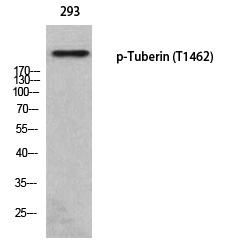
| WB | 咨询技术 | Human,Mouse,Rat |
| IF | 咨询技术 | Human,Mouse,Rat |
| IHC | 1/100-1/300 | Human,Mouse,Rat |
| ICC | 1/200-1/1000 | Human,Mouse,Rat |
| FCM | 咨询技术 | Human,Mouse,Rat |
| Elisa | 1/5000 | Human,Mouse,Rat |
| Aliases | TSC2; TSC4; Tuberin; Tuberous sclerosis 2 protein |
| Entrez GeneID | 7249; |
| WB Predicted band size | 200kDa |
| Host/Isotype | Rabbit IgG |
| Antibody Type | Primary antibody |
| Storage | Store at 4°C short term. Aliquot and store at -20°C long term. Avoid freeze/thaw cycles. |
| Species Reactivity | Human,Mouse,Rat |
| Immunogen | Synthesized peptide derived from human Tuberin around the phosphorylation site of T1462. |
| Formulation | Purified antibody in PBS with 0.05% sodium azide,0.5%BSA and 50% glycerol. |
+ +
以下是关于Tuberin (Phospho-Thr1462)抗体的3篇参考文献,涵盖关键机制研究和抗体应用:
1. **"TSC2 is phosphorylated and inhibited by Akt and suppresses mTOR signalling"**
- **作者**: Inoki, K., et al.
- **摘要**: 本研究揭示了Akt激酶通过磷酸化TSC2蛋白的Thr1462位点,抑制其功能,从而解除对mTORC1信号通路的调控,促进细胞生长。研究利用Phospho-Thr1462抗体验证了该位点的磷酸化与mTOR活性的关系。
2. **"Identification of the tuberous sclerosis complex-2 tumor suppressor gene product tuberin as a target of the phosphoinositide 3-kinase/Akt pathway"**
- **作者**: Manning, B.D., et al.
- **摘要**: 文章证实Akt通过磷酸化TSC2的Thr1462位点,阻断TSC1/TSC2复合体对Rheb的GAP活性,导致mTORC1信号激活。研究中采用Phospho-Thr1462抗体进行免疫印迹分析,支持Akt依赖性磷酸化的分子机制。
3. **"Activity of TSC2 is inhibited by AKT-mediated phosphorylation and membrane partitioning"**
- **作者**: Cai, S.L., et al.
- **摘要**: 本文探讨AKT介导的TSC2 Thr1462磷酸化如何影响其亚细胞定位及功能。通过Phospho-Thr1462抗体检测,发现磷酸化导致TSC2从膜结构解离,进而丧失对mTOR通路的抑制作用,与肿瘤发生相关。
这些文献均涉及Thr1462位点的磷酸化机制,并展示了该抗体在机制研究中的关键应用,如Western blot验证和功能分析。
Tuberin, encoded by the *TSC2* gene, is a critical regulatory protein that forms a complex with hamartin (TSC1) to suppress the mTORC1 signaling pathway, thereby modulating cell growth, proliferation, and autophagy. Phosphorylation at Thr1462 is a key post-translational modification regulating tuberin activity. This site is phosphorylated by kinases such as Akt (protein kinase B) and RSK (p90 ribosomal S6 kinase) in response to growth factor or insulin signaling. Phosphorylation at Thr1462 disrupts the TSC1-TSC2 complex, relieving mTORC1 inhibition and promoting downstream anabolic processes. Dysregulation of this phosphorylation event is implicated in tuberous sclerosis complex (TSC), cancers, and metabolic disorders.
The Tuberin (Phospho-Thr1462) antibody specifically detects tuberin phosphorylated at Thr1462. enabling researchers to study mTOR pathway activation status in various contexts. It is widely used in techniques like Western blotting, immunohistochemistry, and immunofluorescence to assess signaling dynamics in cell lines, tissues, or disease models. Proper sample preparation (e.g., using phosphatase inhibitors) is essential to preserve phosphorylation signals. Validation with phosphorylation-deficient mutants or kinase inhibitors ensures antibody specificity. This tool is pivotal for understanding disease mechanisms linked to mTOR hyperactivation and evaluating therapeutic strategies targeting this pathway.
×